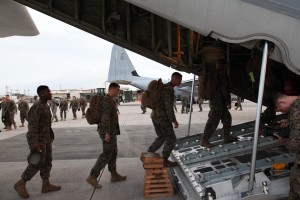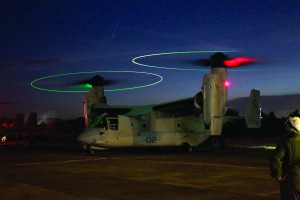2013-11-11 In recent testimony before the House Armed Services Committee, the Commandant of the USMC highlighted the importance of readiness to the Corps in performing its global missions.
Our nation expects a force capable of responding to crisis anywhere around the globe at a moment’s notice. Readiness is the critical measure of our ability to do that.
This is our nation’s strategic hedge against uncertainty. In times of crisis…forward deployed naval forces provide decision makers with immediate options that can control escalation, buy time, create decision space for our national leaders, and enable follow-on Joint forces.
The Marine Corps’ high readiness levels mitigate the risks inherent in an uncertain world by responding with a wide range of capabilities across real-world scenarios.
Your Marines remain a constant, effective hedge against the unexpected, and provide the American people a national insurance policy.
Our world is a dangerous place and America must always be ready to meet emerging crisis that threaten our national security interests.
HASC SCMR_CMC Opening Statement_As_Delivered
The importance of readiness is being reinforced by current events in the Philippines.
And only a few days prior to these events, the Commandant was on the Hill underscoring how important readiness is to the world as it is.
According to an article by Sydney Freedberg, Jr in Breaking Defense:
The Marine Corps, by contrast, has not cut readiness – but only at the price of slashing everything else, from base maintenance to weapons programs.
That can’t go on indefinitely, the commandant said. “I’m paying that price to maintain that readiness, to be your crisis response force, but that will only last probably not later than 2017.
I’ll start seeing erosion in around a year and a half,” said Gen. Amos.
Readiness means just that: being ready to engage.
The enemy in this engagement: dealing with the consequences of the recent Typhoon upon the Philippines.
The typhoon, which has hit the Philippines, is devastating.
Relief agencies are being mobilized to respond, and among the key capabilities, which are, being sent to help is the 3rd MEB. Already the 3rd MEB has responded with the V-22 as a key lead element.

The USMC is well positioned to help with its air enabled, and rapid response capabilities.
As Col. Weisz has argued in an overview article about the USMC/USN team and HA/DR missions:
Humanitarian assistance/disaster relief (HA/DR) operations are a core element, which the US military is tasked to do. It is also a key part of exercising forward presence and for shaping the kind of domain knowledge essential to global operations.
In the last 5 years, III MEF and its major subordinate commands have deployed thousands of personnel and associated equipment throughout the U.S Pacific Command’s (USPaCom’s) area of responsibility in support of HA/DR missions.
Weisz went on to describe two of these missions: Operation UNIFIED ASSISTANCE (OUA) conducted from December 2004 through February 2005 and the Philippines HA/DR mission conducted during the September-October 2009 period.
Typhoon Haiyan has impacted more than 4.2 million people across 36 provinces in the Philippines, according to the Philippine government’s national disaster risk reduction and management council.
Since 1990, the U.S. Government has responded to more than 40 disasters in the Philippines at the request of that country’s government, ranging from volcanic eruptions, drought, and population displacement.
MCAS Futenma is a mission ready air station capable of continuous aviation and base operating support for tenant organizations and follow-on U.S., Allied, and United Nations forces during combat or contingency operations in the Western Pacific Theater of operations, to include U.S. Pacific Command, Marine Corps Forces Pacific and Marine Corps Installations Pacific.

According to the former Deputy Commandant of Aviation, Lt. General (retired) George Trautman, the augmentation of capability represented by the Osprey is an important step as well for handling such crises:
“This is where III MEF/3d MEB and 1st MAW excel. Now that they have V-22’s they are something to behold.”
According to a senior Marine officer the current effort is beginning to roll out as follows:
Four MV-22s and 3 KC-130s have departed for the Philliplines.
One KC-130 is returning to Okinawa with the ACE for the 3rd MEB to be 4 MV-22st and 4 KC-130s.
MAG-36 XO (Marine Aircraft Group 36) has the lead on the site with 1st MAW (1st Marine Air Wing) AGSD (Aviation Ground Support Department Head), G-6 (G-6 Operations Officer), G-3 (G-3 Operations Officer), and MACG-18 (Marine Air Control Group-18) continue to refine FOB (Forward Operating Base), FARP ( Forward Arming and Refueling Point), MMT (Marine Air Traffic Control Mobile Team) requirements in anticipation of potential tasking.
In the video below above, 3rd MEB activity involving approximately 90 Marines and Sailors with 3rd Marine Expeditionary Brigade and two KC-130J Hercules aircraft with Marine Aerial Refueler Squadron 152, Marine Aircraft Group 36, 1st Marine Aircraft Wing deployed from Okinawa are shown in support of the Philippines in wake of Super Typhoon Haiyan.
Credit: III Marine Expeditionary Force / Marine Corps Installations Pacific
11/10/13
The picture of the Osprey above highlights the importance of training to work together PRIOR to crisis response.
The Osprey prepares for take off for night low-altitude training Jan. 24 on Antonio Bautista Air Base in Puerto Princesa, Palawan, Republic of the Philippines.
Ospreys conducted day and night low-altitude training Jan. 23-24 2013 in the Republic of the Philippines, marking the Marine Corps’ first Osprey training in the Republic of the Philippines and the first low-altitude training the pilots and crew have conducted since the aircraft’s Oct. 2012 arrival to Okinawa.
The Osprey pictured is with Marine Medium Tiltrotor Squadron 265, Marine Aircraft Group 36, 1st Marine Aircraft Wing, III Marine Expeditionary Force.
Credit: 1st MAW.
Sydney Freedberg, Jr. highlighted the challenge of such a relief effort as follows in his piece today on Breaking Defense:
For the really heavy hauling, you need the ships, aircraft, and people of what’s called the “Gator Navy” — something no other nation has.
The Gator Navy comprises 30 amphibious warfare ships designed to carry Marine Corps forces: troops, tanks, and supplies; helicopters, V-22 tilt-rotors, and hovercraft to get Marines and their gear ashore in a hurry; and even Marine Corps fighter jets for close air support.
The largest of those ships, at 40 to 50,000 tons displacement, are what the US calls its nine “big-deck amphibs.”
Any other navy would call them an aircraft carrier, but the US Navy disdains to use that term for anything smaller than its ten 100,000-ton nuclear-powered behemoths.
The Navy is now building massive new “Mobile Landing Platform” and “Afloat Forward Staging Base” ships to move even more supplies ashore without needing to use a port.
We also have the two famous hospital ships, Comfort and Mercy. This force was primarily bought and built to deploy combat troops to hostile shores, the kind of amphibious warfare that’s been a Marine Corps specialty since before World War II.
In fact, the current fleet of 30 amphibs is considered not enough to meet the Marines’ requirements for a major conflict.
But it’s plenty to deliver supplies and personnel to a coastal disaster zone.
The video below from 3rd MEB provides reporting from Cpl. Elizabeth Case about the initial departure from Japan.

